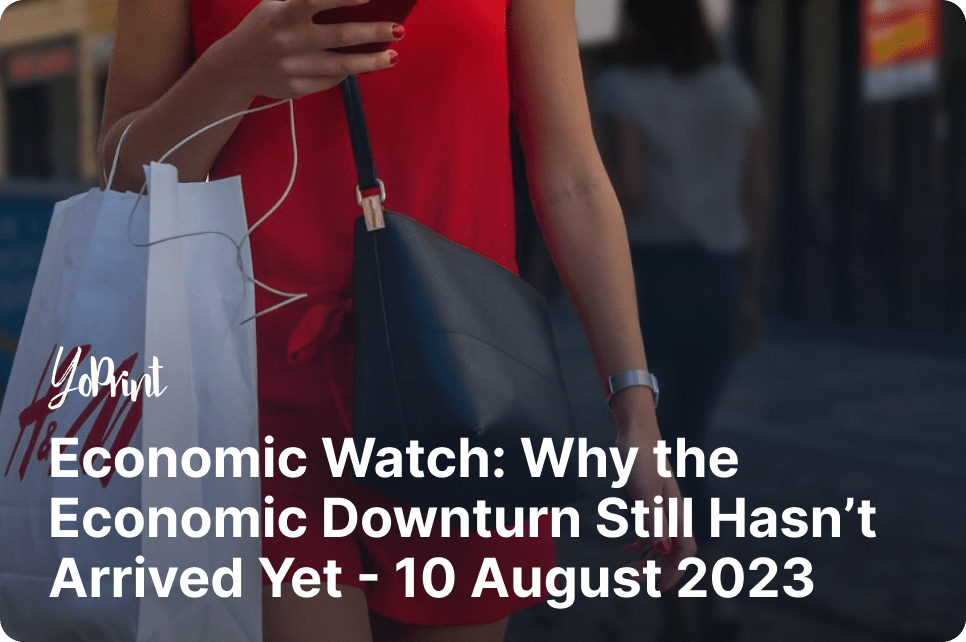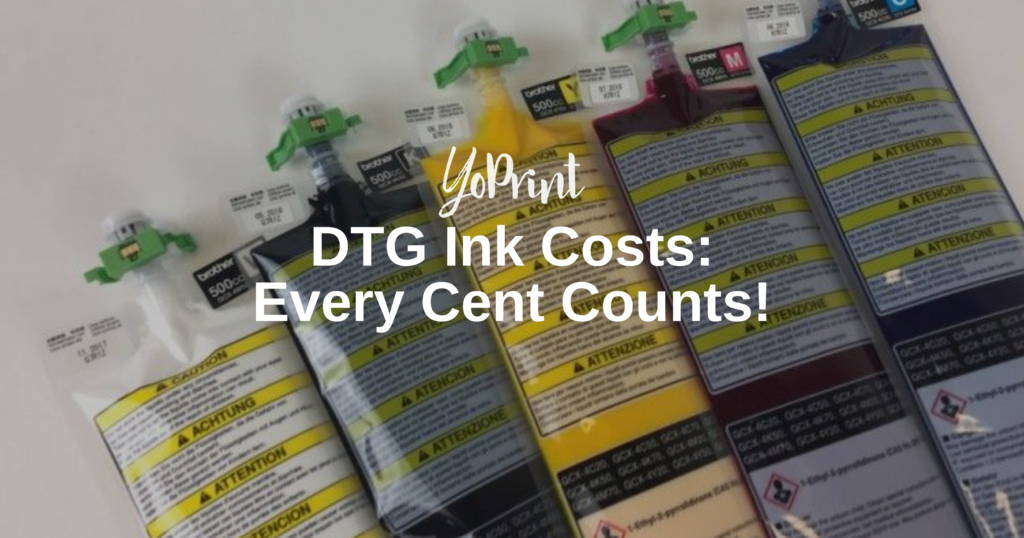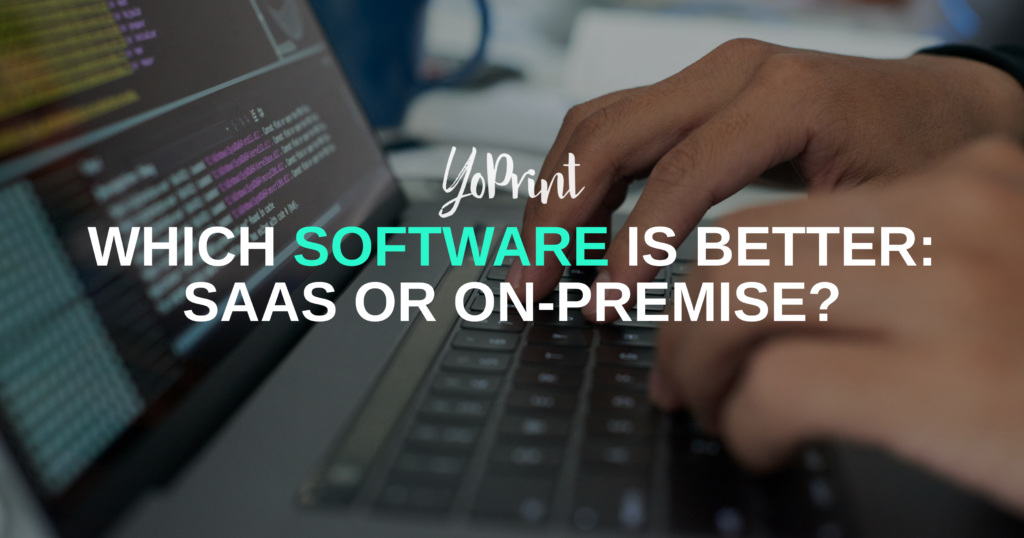- Apparel companies still seeing weakening consumer demand and expect macro trends to continue this downward trend throughout the rest of the year
- A recession won’t happen just yet, but most likely in late 2023 or early 2024, based on current economic conditions such as a still-robust labor market and some residual consumer spending
- It’s still prudent to play it safe and strengthen your print shop’s financial position in anticipation of an impending recession
With the new month comes a new monthly economic forecast, but while there have been some changes across the board, the long-term consensus remains the same: a downturn isn’t happening as soon as was first predicted. So has anything really changed since last month? Well, yes and no. Let’s take a closer look.
Macro Trends in Apparel
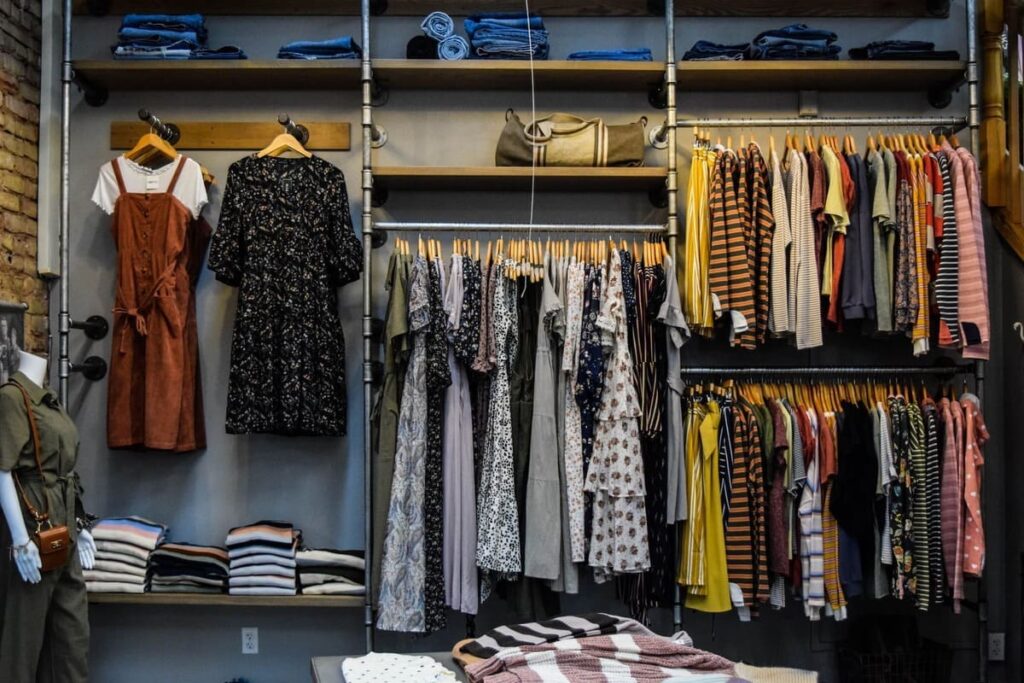
LVMH recorded a 3 percent increase in “organic growth” for the first half of the year, “of which plus 8 [percent] in Q1 and minus 1 [percent] in Q2.” They continue to note the “softer demand from American consumers compared to other Western clienteles (sic),” a trend they’ve observed occurring in “varying degrees amongst brands.” In their Q2 earnings call, they report:
“…we have a situation where, by and large, the aspirational customer is suffering a bit. We are experiencing drops with enterprise products with online sales with second-tier cities, which is a clear sign that the aspirational customer is not shopping as much as they used to.”
LVMH Q2 Earnings Call
Meanwhile, Gildan also paints a poorer outlook for the rest of the year, especially with how “current market conditions unfavorably impact activewear product mix, both in North American and International markets, as customers focus on lower-priced products.” Even though they’ve experienced “better-than-expected sales” in activewear, as well as in hosiery and underwear, they nonetheless believe in the prudence of tempering expectations for the rest of the year.
Columbia Sportswear is also looking dour with its outlook of 2023: net sales are currently “expected to increase 2 [percent] to 3.5 [percent] from 2022;” previously, expectations were between “3 [percent] to 6 [percent].” They’ve commented on their brands not being “immune to macroeconomic pressures and headwinds” as “sell-through trends softened, reflecting cautious consumer behavior.”
It’s a similar story with the e-commerce fashion retailer Revolve Group, Inc. With its second-quarter revenue falling short of expectations, the Revolve Group shared a similar sentiment: “Aspirational consumer discretionary spending remains challenging, particularly on goods in the US for our younger customer demographics.”
We continue to maintain that apparel spending is still fluctuating, with expectations that things won’t improve for a while, especially as American consumers continue to manage their overall spending habits in favor of groceries, bargain buys, and more savings for rainy days to come.
Why There Won’t Be a Downturn Just Yet
What’s happening in the apparel industry is only one small part of the story. Overall, plenty of indicators signal positive economic trends, which is always welcome news to quell the worries about an impending recession.
GDP
Real GDP in the second quarter went up at a 2.4 percent quarter-over-quarter annual rate, while nominal GDP was also up by 4.7 percent. Real GDP in the second quarter saw a healthy increase from the previous quarter, though it’s the opposite for nominal GDP: it slowed from 6.1 percent in Q1 to 4.7 percent. This latter part is good news, though, as a cooling nominal GDP is “vital for cooling inflation,” which shows the Federal Reserve’s plan is taking some hold, although it’s still slower than they hoped for.
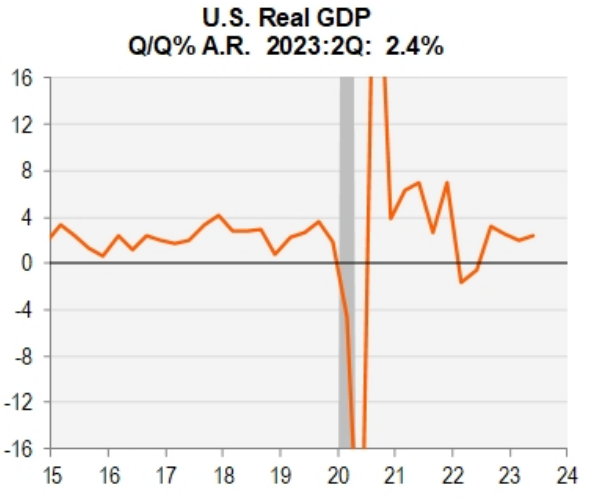
Consumer consumption (a.k.a., consumer spending) helped contribute to “half of headline real growth,” which indicates that retail sales spending is still in a good place. Again, this can still change drastically as the year forges on with the possibility of “drawdown[s] of excess savings, worsening credit, likely 4Q layoffs, and slowing wage growth,” to name a few.
Employment
The unemployment rate is still at historic lows, with the July figure standing at 3.5 percent (a 0.1 percent drop from June). Meanwhile, initial unemployment claims went up 6,000 to a “seasonally adjusted 227,000” for the week ended July 29th. The week before that, initial claims had dropped by 7,000 to 221,000, the lowest it’s been since February this year; the four-week average for initial claims also fell by 3,800 week-over-week.
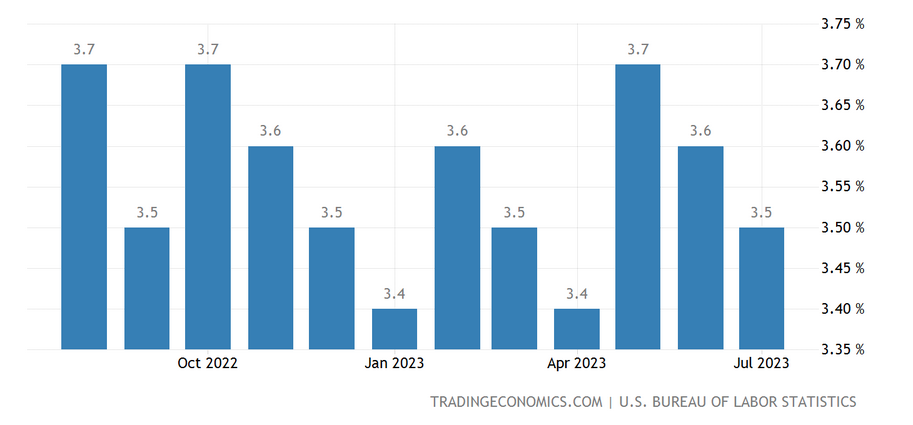
On the other hand, continuing claims increased by 21,000 to 1.7 million in the week ending July 22nd. They are also at historic lows, further “extending their post-April downtrend.” Its four-week average has also declined week-over-week, indicating that unemployed persons weren’t having much trouble finding new jobs.
Nonfarm payrolls also increased by 187,000 jobs in July, just a little higher than June’s seasonally adjusted 185,000 – which was previously reported as 209,000. Layoffs also reduced by 42 percent from June, indicating the job market is still relatively stable.
Stable Spending
Based on the Bank of America’s aggregated credit & debit card data, total card spending per household went up 0.7 percent year-over-year in the week ending Jul 22nd. A peak in year-over-year spending on both entertainment and clothing was likely due to the box office successes of the Barbie and Oppenheimer films.
Meanwhile, foot traffic in July saw an uptick led by recreation venues (including cinemas, again due to how popular Barbie and Oppenheimer turned out to be) and discount stores.
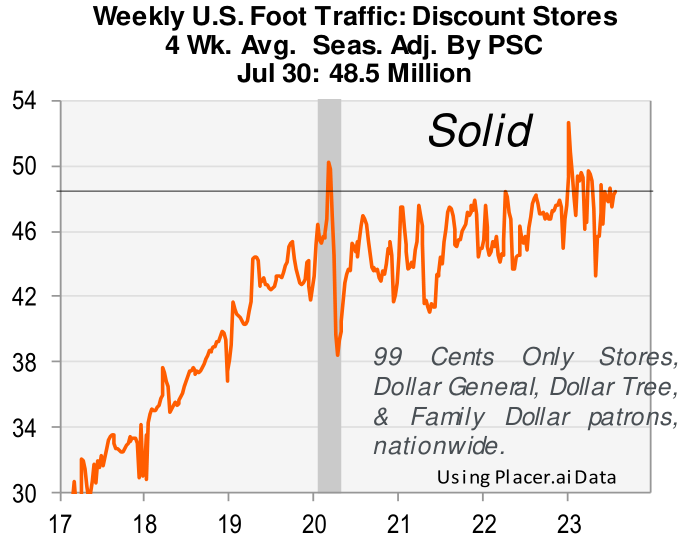
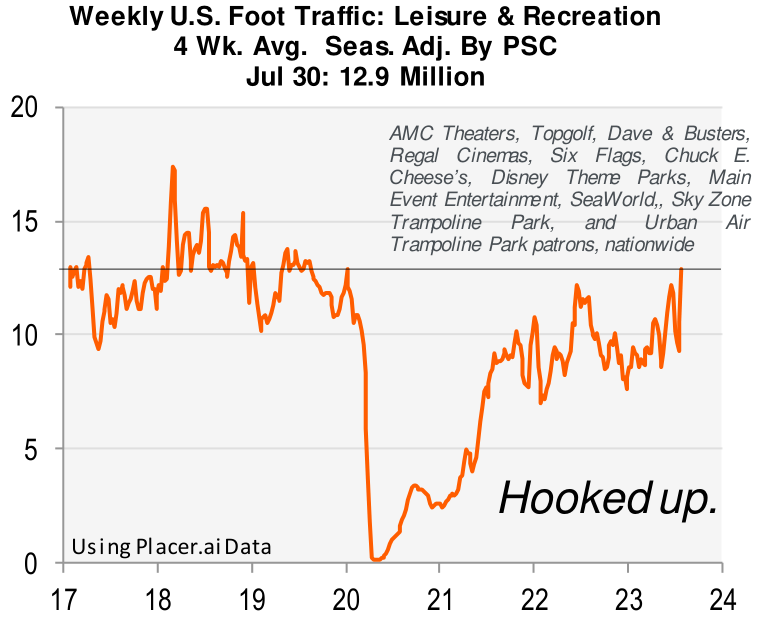
Average hourly earnings had increased by 4.4 percent in June (0.4 percent on a month-on-month basis). Nominal personal income has slowed to an extent but remained at elevated levels. On top of “excess savings drawdowns and borrowing,” this helped spur consumer spending despite how much higher costs have skyrocketed. This will undoubtedly change through the second half of the year.
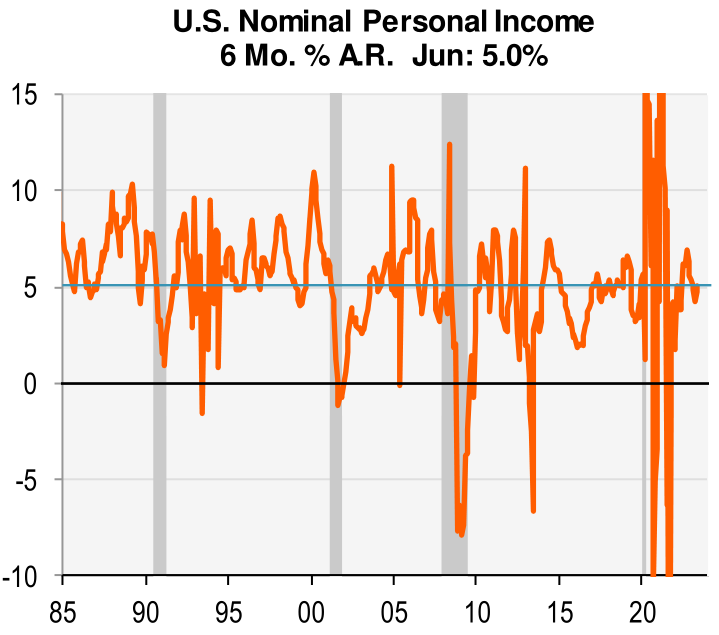
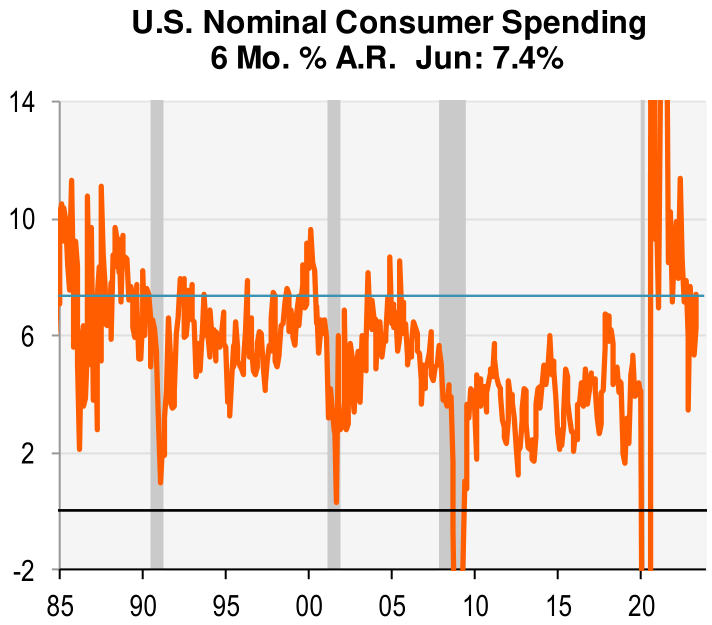
As a whole, consumer finance metrics remain solid by most measures. However, elevated interest rates following tightening by the Federal Reserve and the current mortgage backdrop will likely have a long-term adverse impact on consumer spending habits throughout the year.
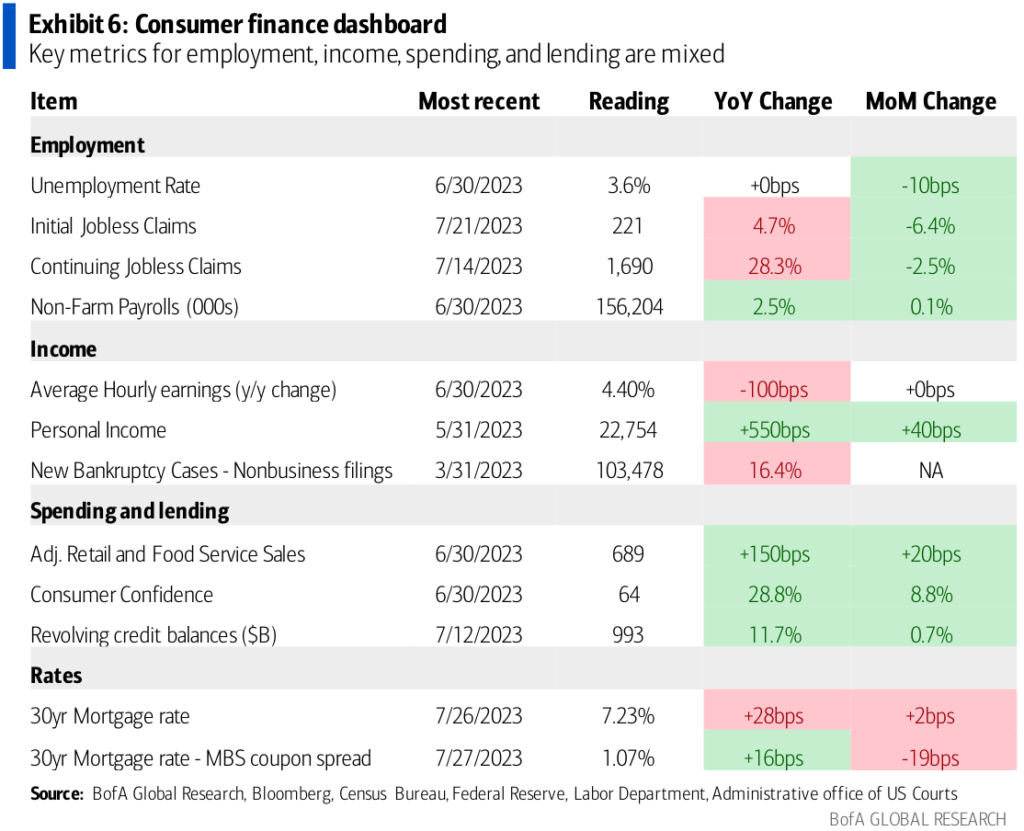
Consumer Confidence
The “continued slowdown in inflation” and robust job market continue to positively affect consumer confidence, as evidenced by the University of Michigan’s Surveys of Consumers seeing an 11 percent increase from June – the most favorable since October 2021.
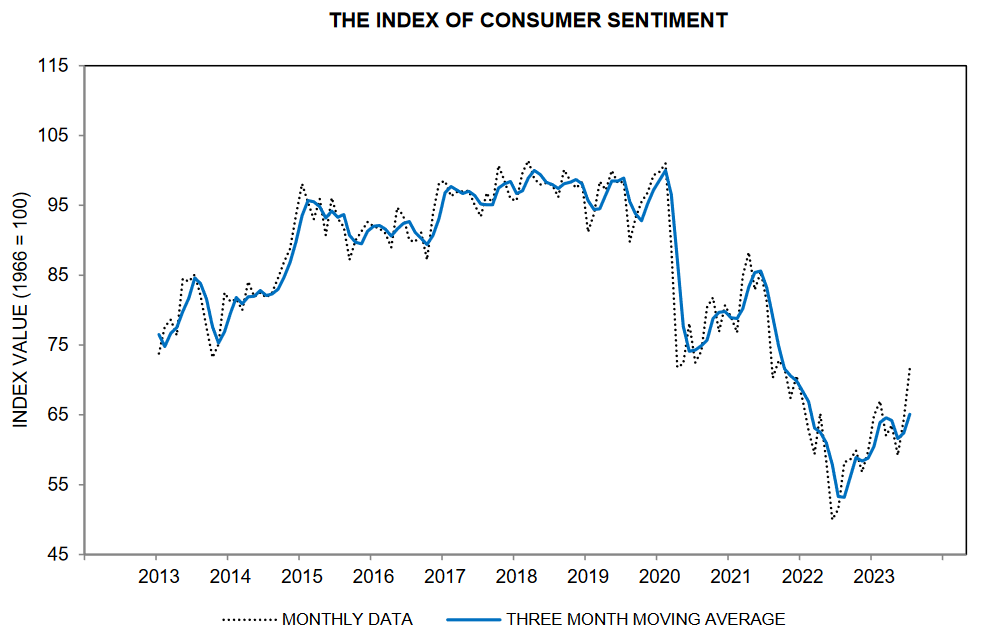
Given the stock market’s “recent pullback” and a 20-cent increase in gas prices “over the past two weeks,” Piper Sandler notes a pause in consumer confidence. It remains uncertain how long this will last or if it might be a sign of things to come.
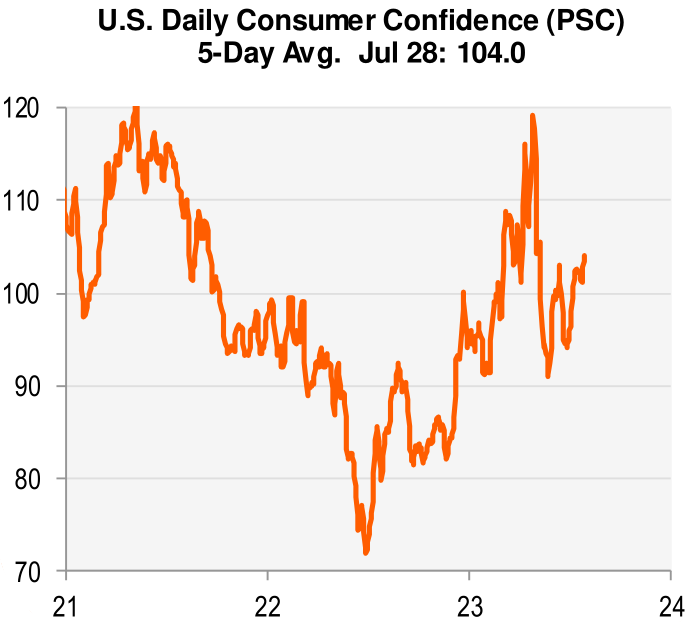
Purchasing Managers Index (PMI)
Despite experiencing yet another contraction for the ninth consecutive month, the manufacturing PMI – as reported by the Institute for Supply Management (ISM) – moved up slightly to 46.4, though marginally lower than the Dow Jones’ expectations of 46.8; this is a 0.4 percentage point increment from June. Note that a score below 50 indicates a contraction.
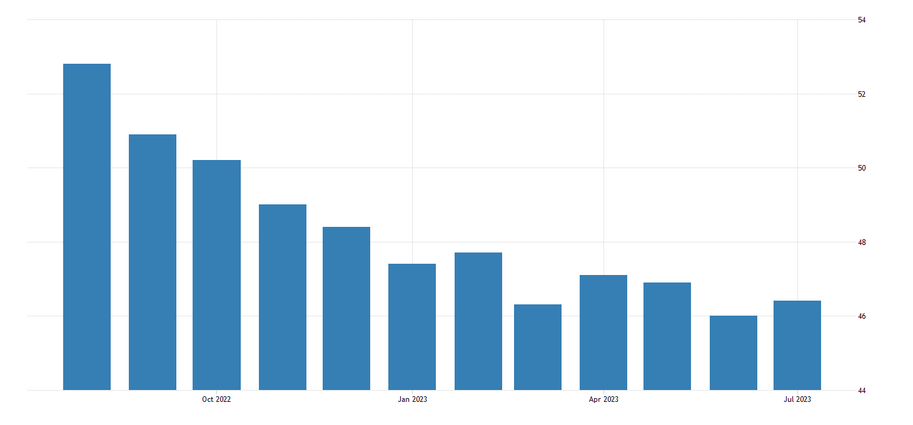
Among the industries that reported a contraction included Apparel, Leather & Allied Products, and Textile Mills.
On the other hand, the Services PMI was going through the opposite: the “services sector expanded in July for the seventh consecutive month” at 52.7 percent. This marks continuous growth in “37 of the last 38 months”, with only a single contraction in December 2022.
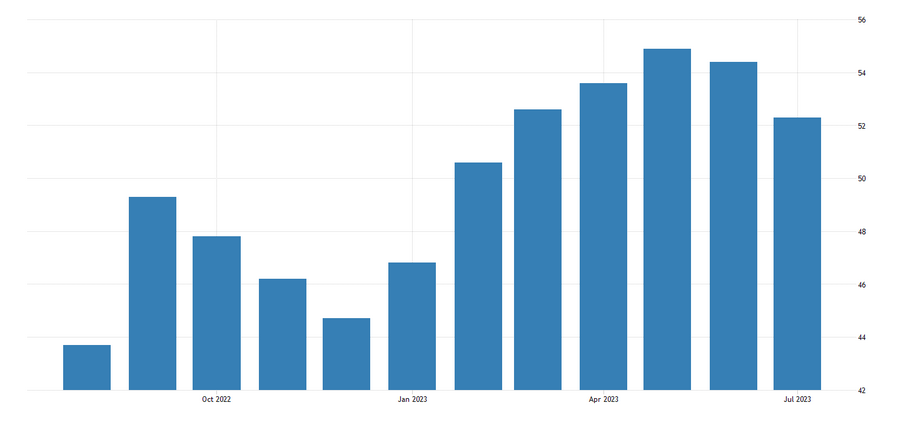
When the Recession Eventually Arrives…
The risk of a recession may be low thanks to the current economic climate, but one is bound to happen eventually. After all, economic acceleration isn’t an unusual turn of events before a downturn occurs; history has proven that it’s happened before – 1968, 1973, 1990, and 2007, to be more specific. It’s always the calm before the storm that lulls us into a false sense of security, and by the time it hits, we might be woefully unprepared for the aftermath.

Telltale Signs on the Horizon
The tight job market, elevated income levels, and worryingly high inflation (despite the ongoing cooling) are just two of the many indicators of what’s to come. We’ve already pointed out that a slowdown in nominal GDP can be good in cooling inflation; it also means that companies will have lower pricing power – especially when prices are now high, and consumer spending continues to weaken. This, in turn, will lead to waning corporate revenues and lower margins, followed by renewed staff layoffs for the company to stay afloat.
Moreover, the Fed’s rate hikes have always stalled corporate revenue after about a year or so, and we’ve already seen how corporate revenues have stalled in the first quarter of 2023 when the Fed started hiking rates since March last year. On top of tighter lending standards due to the rate hikes and the incredible wage gains that are starting to pressure real corporate revenues, there are also the current price pressures on consumers, the continuing “popping of the stay-at-home bubble,” and slowing demand for goods and services, among other things.
Essentially, according to Piper Sandler:
“Slowing nominal growth implies slowing inflation – and a continuing slowdown in corporate revenue growth [means] bad news for margins, and in turn, employment & wage growth down the line.”
Piper Sandler analysis
Take a look at the International Union, United Automobile, Aerospace and Agricultural Implement Workers of America (UAW) demanding better pay – in this case, a 40 percent increase – and the Writers Guild of America’s (WGA) strike. With the former, the UAW’s intention to strike in mid-September can also significantly hit automakers’ revenues if it does happen. As for the latter, the major players in the entertainment industry will feel a considerable pinch should the strike continue well into the end of 2023.
All in all, we expect the latter half of 2023 to be a bumpy ride.
A Cooling Labor Market
The labor market may be riding on the low unemployment rate, but even that will come to an end. As we’ve already pointed out in our discussion of the HOPE framework, employment is a lagging economic indicator that changes, on average, between 18 to 24 months after the Fed has begun tightening efforts. Even now, job demand is starting to wane slowly, but it is very slow.
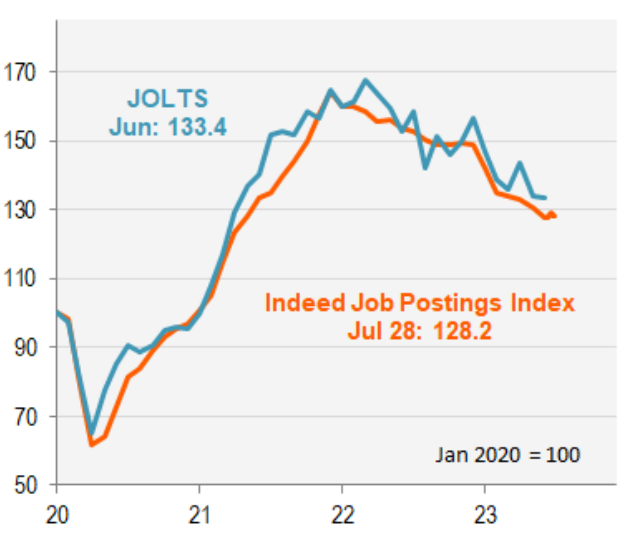
Consider June’s JOLTS record, which totaled 9.58 million from May’s 9.62 million. This is currently the lowest it’s been since April 2021. Meanwhile, JOLTS-recorded layoffs decreased from 1.55 million in May to 1.53 million in June. Temp employment also slipped lower, an indicator that payrolls will decrease as we head into a potential recession.
Can We Expect a Hard or Soft Landing?

There are mixed opinions about whether a hard or soft landing will happen. Piper Sandler believes we’re in for a hard landing, anticipating the worst will happen in 2024. They believe that, based on the three prior soft landings in the past, “bank lending standards were on the easy side (above zero).” In their view, the odds of a soft landing are very unlikely, with current lending standards only getting tighter.
Piper Sandler also forecasts that unemployment will shoot up to 6 percent either in the fourth quarter of 2023 or mid-2024, while consumer spending will weaken at the end of the year, which will thus prompt companies to layoff staff to keep corporate revenues stable (and hence, lead to the 6 percent unemployment rate).
On the other hand, the Bank of America believes that we might be in for a soft landing. GDP will possibly turn negative for two quarters in the first half of 2024, but “at only -1.0 [percent] and -0.5 [percent] [quarter-over-quarter] [seasonally adjusted annual rate] for 1Q 24 and 2Q 24.” Their “projected downturn remains mild by historical standards” as they’re optimistic about disinflation happening without further weakening the labor market; they predict unemployment will peak at 4.7 percent in the fourth quarter of 2024.
Of course, these are only economists’ forecasts, which can still be wrong. We’ve already seen how initial forecasts of a recession in 2023 were disproven thanks to varying tailwinds in the economy. Even before that, we’ve had doomsayers predicting a recession back in 2022 – and even then, it never happened.
Despite some concerns, we’re quite optimistic about the rest of this year being recession-free. You’d still do well to plan for the stormy weather that’s been predicted. And even if a recession doesn’t happen in 2024, you can still rest easy knowing you did something good for your print shop.
Preparing for a Recession
Future-proofing your business now will ensure you won’t be hit hard when the recession comes around. Here are a few pointers to get you started.
Solidify Your Cash Flow
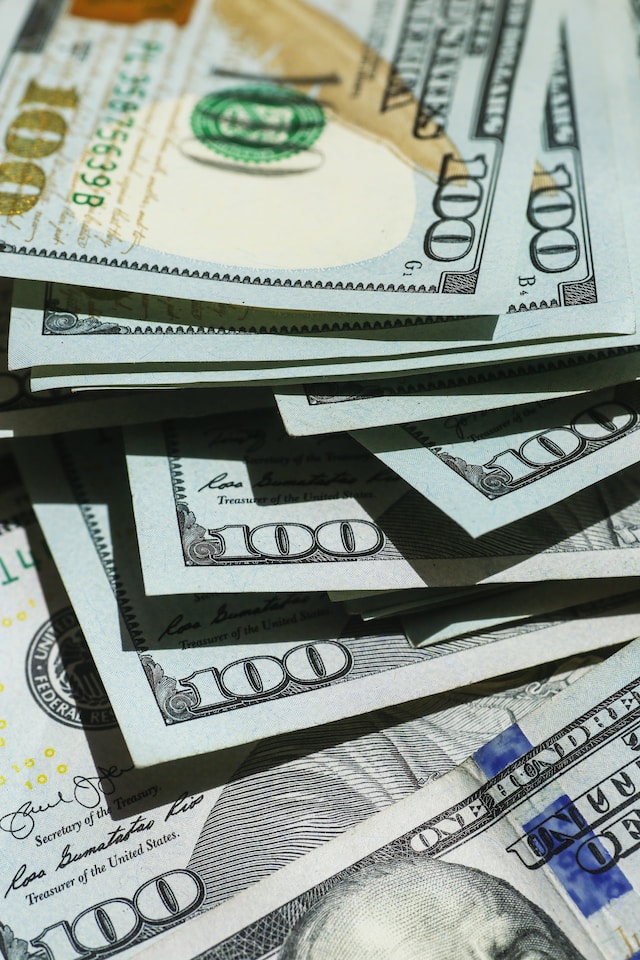
Your print shop’s cash flow should always be positive, even when you’re not busy with many customer orders. In times like these, you must be more wary of where you’re putting your hard-earned money and whether the outcome will succeed. We’ll continue to warn against making big financial commitments such as purchasing new equipment or a new location to move to or a new branch.
There’s no guarantee that a big decision will lead to major profitability, especially when discretionary consumer spending is starting to weaken ever so slowly. If you put down money in a big investment, then find that you’re suddenly running at a loss within a few months, that’s a whole lot of money that’s gone to waste. Nothing is certain, but if the risks are substantial, it’s always best to play it safe.
You’d also have to consider your utilities, staff wages, unexpected maintenance cycles, etc. Even the best-laid plans don’t always work out, after all. Consider shoring up your finances first, saving up for the future, and having a healthy cash flow to help you out when things get rough.
Strengthen Your Customer Base
New customers will be difficult to find once consumer spending diminishes. You’ll have to start looking to your regular crowd to help you keep your business afloat: help me, help you. It won’t be easy, but we’ve outlined some useful tips to help you boost your profitability even when you don’t have any customer growth.
Building on your existing customer base can pay huge dividends as you go on, helping you strengthen your print shop’s finances and potentially woo new customers through various means.
Keep Calm and Carry On
Cliché though the line may be, the least you can do is focus on the present and not worry about the uncertainty ahead of you. As long as you stay focused on building on your shop’s capabilities and improving the overall customer experience, you’ll do just fine.
